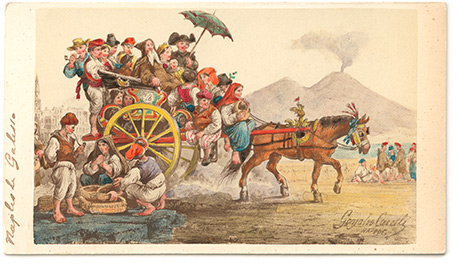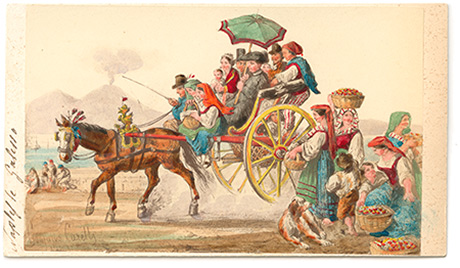Marking time in April 2017
Neopolitan tourism
Here are two delightful travellers’ souvenirs in the form of carte-de-visite photos—reminders of a visit to Naples. I’m guessing a tourist bought them after visiting the excavations at Pompeii in the 1860s.

The carte-de-visite was the first broadly-affordable kind of photograph. Most cartes were posed studio portraits, but there was also a market for views of scenes and places, as we see here.

The photographic materials used—the wet-plate collodion negative and the albumen print—could only record static subjects, and only in monochrome. But these two pictures have captured the colour and movement of the scene because they are reproductions of an artist’s drawings, with colour added by hand to each print. The artist was Consalvo Carelli, an Italian landscape painter who is also remembered for the illustrations he made for a travel journal of Alexandre Dumas.
For me these souvenirs evoke the time when mass tourism was just starting—made possible, for a growing middle class of Europeans, by the steam ship and the railway. Those tourists turned to a newly popular literary genre—the travel guide. Here are some tips on getting around in Naples from Karl Baedeker:
Carriages. The distances in Naples are so great, the charges are so moderate, and walking in the hot season is so fatiguing, that there is little inducement for pedestrianism. A private two-horse carrozzella for excursions costs 15-25 fr. per diem; in the town 15 fr. and gratuity. They are to be hired at the hotels, at S. Lucia etc. The fares of the public vehicles are considerably lower: two-horse carrozzella per drive during the day 1 fr., from sunset to midnight 1 fr. 50 c.; by time: 2 fr. for the first hour. 1 fr. 50 c. for each successive hour; at night 2 fr. 25 c. for the first, 2 fr. 65 c . for each successive hr. —One horse carrozzella per drive 50 c., at night 65 c.; by time (generally disadvantageous): 1 f:·. 25 c. for the first, 1 fr. for each successive hr.; at night 1 fr. 65 c. and 1 fr . 25 c. respectively. From midnight to sunrise double fares. In hiring by time any fraction above an hour is charged as 1/2 hr. In order to avoid imposition the best rule to observe is to pay the strict fare and not a single soldo in addition. Those who are disposed to pay liberally are sure to be victimized. In case of disputes, application should be made to the nearest policeman. [Karl Baedeker, Italy: handbook for travellers (Coblenz, 1867).].
